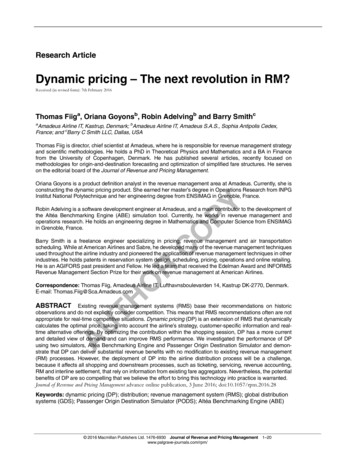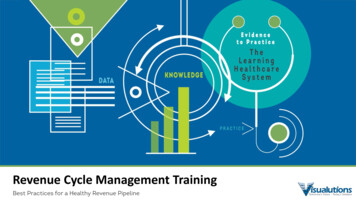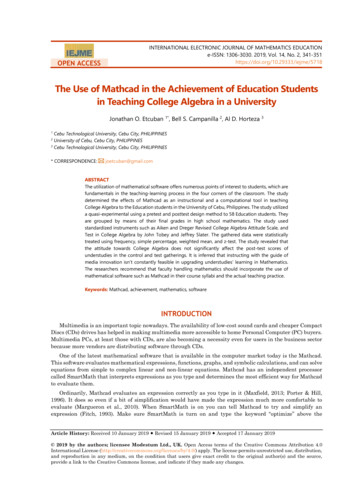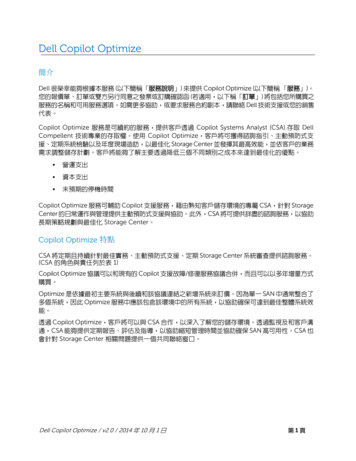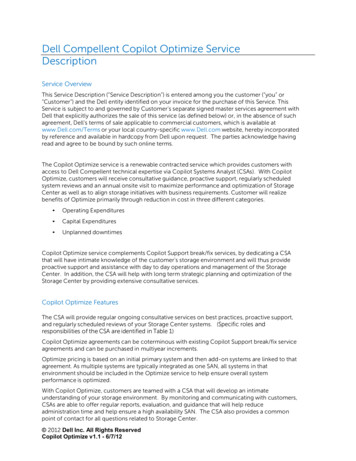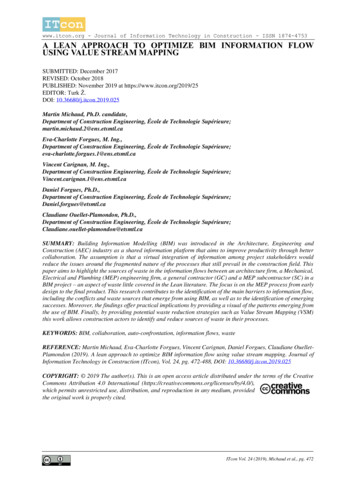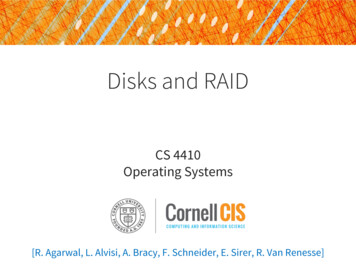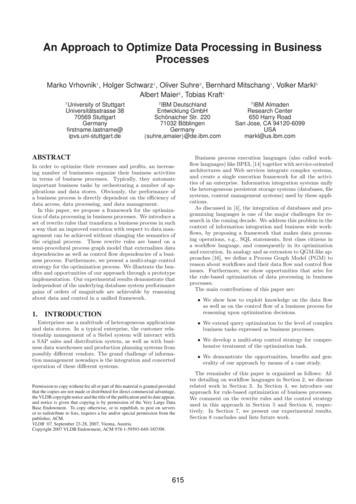
Transcription
An Approach to Optimize Data Processing in BusinessProcessesMarko Vrhovnik1 , Holger Schwarz1 , Oliver Suhre2 , Bernhard Mitschang1 , Volker Markl3Albert Maier2 , Tobias Kraft11University of StuttgartUniversitätsstrasse 3870569 art.de2IBM DeutschlandEntwicklung GmbHSchönaicher Str. 22071032 In order to optimize their revenues and profits, an increasing number of businesses organize their business activitiesin terms of business processes. Typically, they automateimportant business tasks by orchestrating a number of applications and data stores. Obviously, the performance ofa business process is directly dependent on the efficiency ofdata access, data processing, and data management.In this paper, we propose a framework for the optimization of data processing in business processes. We introduce aset of rewrite rules that transform a business process in sucha way that an improved execution with respect to data management can be achieved without changing the semantics ofthe original process. These rewrite rules are based on asemi-procedural process graph model that externalizes datadependencies as well as control flow dependencies of a business process. Furthermore, we present a multi-stage controlstrategy for the optimization process. We illustrate the benefits and opportunities of our approach through a prototypeimplementation. Our experimental results demonstrate thatindependent of the underlying database system performancegains of orders of magnitude are achievable by reasoningabout data and control in a unified framework.1. INTRODUCTIONEnterprises use a multitude of heterogeneous applicationsand data stores. In a typical enterprise, the customer relationship management of a Siebel system will interact witha SAP sales and distribution system, as well as with business data warehouses and production planning systems frompossibly different vendors. The grand challenge of information management nowadays is the integration and concertedoperation of these different systems.Permission to copy without fee all or part of this material is granted providedthat the copies are not made or distributed for direct commercial advantage,the VLDB copyright notice and the title of the publication and its date appear,and notice is given that copying is by permission of the Very Large DataBase Endowment. To copy otherwise, or to republish, to post on serversor to redistribute to lists, requires a fee and/or special permission from thepublisher, ACM.VLDB ‘07, September 23-28, 2007, Vienna, Austria.Copyright 2007 VLDB Endowment, ACM 978-1-59593-649-3/07/09.6153IBM AlmadenResearch Center650 Harry RoadSan Jose, CA 94120-6099USAmarkl@us.ibm.comBusiness process execution languages (also called workflow languages) like BPEL [14] together with service-orientedarchitectures and Web services integrate complex systems,and create a single execution framework for all the activities of an enterprise. Information integration systems unifythe heterogeneous persistent storage systems (databases, filesystems, content management systems) used by these applications.As discussed in [4], the integration of databases and programming languages is one of the major challenges for research in the coming decade. We address this problem in thecontext of information integration and business wide workflows, by proposing a framework that makes data processing operations, e.g., SQL statements, first class citizens ina workflow language, and consequently in its optimizationand execution. In analogy and as extension to QGM-like approaches [16], we define a Process Graph Model (PGM) toreason about workflows and their data flow and control flowissues. Furthermore, we show opportunities that arise forthe rule-based optimization of data processing in businessprocesses.The main contributions of this paper are: We show how to exploit knowledge on the data flowas well as on the control flow of a business process forreasoning upon optimization decisions. We extend query optimization to the level of complexbusiness tasks expressed as business processes. We develop a multi-step control strategy for comprehensive treatment of the optimization task. We demonstrate the opportunities, benefits and generality of our approach by means of a case study.The remainder of this paper is organized as follows: After detailing on workflow languages in Section 2, we discussrelated work in Section 3. In Section 4, we introduce ourapproach for rule-based optimization of business processes.We comment on the rewrite rules and the control strategyused in this approach in Section 5 and Section 6, respectively. In Section 7, we present our experimental results.Section 8 concludes and lists future work.
2. WORKFLOW LANGUAGES AND DATAMANAGEMENTpursue various additional approaches to support data management at the choreography level:We focus on the business process execution languageBPEL [14] that is broadly adopted by industry and, hence,can be seen as the de facto standard. BPEL exemplifiescapabilities of typical workflow languages to express business processes1 . Similar to other process specification approaches, BPEL fosters a two-level programming model.The function layer consists of executable software components in form of Web services that carry out the basic activities. The choreography layer specifies a process model defining the execution order of activities. By means of the Webservice approach, BPEL achieves independence from the implementation level of activities and the execution platform.BPEL offers various language constructs to express activities as well as control flow patterns. In the following,we describe the usage patterns of some activities that arerelevant for the further discussion: (i) invoke activities callWeb services during process execution, (ii) assign activitiescreate the appropriate input for activities based on resultsfrom earlier service invocations, (iii) sequence activities sequentially execute activities, (iv) ForEach activities allowto iterate over datasets, and (v) flow activities concurrentlyexecute activities.In most workflow languages, users define process models ina graph-like fashion, supported by corresponding graphicaldesign tools. From a modeling point of view, process designtools favor the description of control flow over data flow.This is also true for BPEL, where control flow is explicitlymodeled, whereas data flow is only implicitly defined byspecifying BPEL variables used as input and output data ofactivities. These variables are also used at the choreographylayer, e.g., as part of conditions in the BPEL loop constructs.The BPEL specification [14] comprises additional activitytypes. Furthermore, it supports elaborated compensationand error handling concepts. So far, the language specification is not finished. Proposed extensions comprise thesupport for human interaction, sub processes and the ability to embed Java code into the business process.r The Oracle BPEL Process Manager provides XPathextension functions that are embedded into assign activities [15]. The statement to be executed on a remotedatabase is provided as parameter to the function. Thefunctions support any valid SQL query, update operations, DDL statements as well as stored procedurecalls. Data retrieved by an extension function is storedin a set-oriented process variable expressed in XML.2.1 Data Management at the ChoreographyLevelIn most business processes, accessing and processing datain enterprise data stores is a central task. Hence, the following primitive data usage patterns have to be supported fora comprehensive data provisioning: (i) Use business data todecide on the control flow. For example, one could use aninventory service to decide whether to call a supplier or not.(ii) Update business data. For example, the delivery timefor an item may change based on information received fromthe supplier of the item. (iii) Retrieve business data andsend it to partners, i.e., clients, services and humans. (iv)Store business data that was changed by partners.The service-oriented approach allows to hide enterprisedata stores behind Web services. This is achieved by socalled adapters that encapsulate SQL-specific functionalityin Web services. They provide a well-documented, interoperable method for data access. Adapters represent provenand well-established technology and are provided by different vendors in a similar way. Nevertheless, database vendors1In compliance to the BPEL specification, we use the termbusiness process to denote processes specified by BPEL.616r Workflow Foundation [13] The Microsoft Windows uses SQL activities to provide database processing aspart of business processes. These activities are organized in so-called activity libraries and executed by aruntime engine. The workflow as well as its variables,activities, and parameters are for example describedby XOML, an extensible object markup language.rProcess Server follows another IBM’s WebSphere approach to bring set-orientation to BPEL and itschoreography layer [7, 8]. It introduces informationservice activities that for example allow to process datain a set-oriented manner expressed via SQL. Furthermore, it allows to pass data sets between activities byreference rather than by value. In this paper, we callsuch a direct integration approach BPEL/SQL.The main common property of all three approaches is thatdata management tasks are explicitly modeled at the choreography layer. Hence, the basic concepts we present here,are applicable to all three approaches. In this paper, wefocus on BPEL/SQL to explain these concepts. We willfurther discuss generality issues in Section 4 and Section 7.So-called SQL activities reflect the mentioned data usagepatterns in BPEL/SQL. They provide read and write accessto BPEL variables. Variables that refer to tables storedin a database system are called set reference variables. Alifecycle management facility is responsible for creating andremoving these tables as needed. Variables of a set-orienteddata structure representing a table that is materialized inthe process space are called set variables. Furthermore, SQLactivities may embed an SQL statement including severalinput parameters as host variables. An input parametermay be a scalar value or a set reference variable, i.e., a tablereference. Input parameters are valid at any position inthe SQL statement where in case of a scalar value a hostvariable or in case of a set reference variable a table name isallowed. Set reference variables as well as set variables maystore the result set of SQL activities. A retrieve set activityis a specific SQL activity that allows to load data from adatabase system into the process space.2.2Sample ScenarioOur example is based on an order handling scenario. Theprocess takes a set of orders and decides whether to processthem directly or not. In the latter case, an employee has toapprove an order according to some business policy. Afterthis approval, the process sends notifications for all rejectedorders. In parallel, it processes the remaining orders. Thisr Oracle BPM is a trademark of Oracle Corporation. Windows Server 2003 is a trademark of Microsoft Corporation.WebSphere and DB2 are trademarks of IBM Corporation.
SQLGroupOrdersByItemIDSQLSQLGroupOrdersByItemID #SR ItemList#RetrieveItemListRETRIEVE #SR ItemList# INTO #SV ItemList#ForEachItemOrderFOREACH #CurrentItem# IN #SV ItemList#OrderFromSupplierSQLSELECT ItemID, SUM(Quantity) AS ItemQuantityFROM #SR Orders#WHERE Approved 1OrdersGROUP BY ItemIDInsertOrderConfirmationSQLINVOKE OrderFromSupplierIN: #CurrentItem.ItemID#, #CurrentItem.ItemQuantity#,OUT: #OrderConfirmation#INSERT INTO #SR OrderConfirmations#VALUES ty#,Confirmations#OrderConfirmation# )(a) BPEL Business Process 'OrderProcessing' and its Control Flow(b) SQL Statements behind SQL Activities;Data Dependencies and Data StoresFigure 1: Sample ProcessSELECT ItemID, SUM(Quantity) AS ItemQuantityFROM #SR Orders#WHERE Approved 1OrdersGROUP BY ItemID #SR ItemList#RetrieveItemListRETRIEVE #SR ItemList# INTO #SV ItemList#ForEachItemOrderFOREACH #CurrentItem# IN #SV ItemList#SQL OrderFromSupplier InsertOrderConfirmationOrderINSERT INTO #SR OrderConfirmations# ConfirmationsVALUES .ItemQuantity#))(a) Process 'Order Processing' After First Optimization StepSQLGroupOrdersByItemIDSELECT ItemID, SUM(Quantity) AS ItemQuantityFROM #SR Orders#WHERE Approved 1OrdersGROUP BY ItemID #SR ItemList#SQLForEachItemOrderINSERT INTO #SR OrderConfirmations#SELECT ItemID, ItemQuantity, OrderFromSupplier(ItemID,ItemQuantity)FROM #SR ItemList#OrderConfirmationspart of the overall scenario, i.e., the automatic processingof approved orders, is depicted in Figure 1(a). Modelingthis process in BPEL/SQL is quite straightforward. Activity GroupOrdersByItemIDs creates a set of orders each containing an itemID and the required quantity. ForEachItemOrder now iterates over these orders. A Web service call(OrderFromSupplier ) submits the orders to suppliers, whichreturn confirmation information whether they can supplythe requested items or not. Activity InsertOrderConfirmation makes this confirmation persistent.We show SQL statements and additional informationfor the sample process in Figure 1(b). For clarity wemark BPEL variables by surrounding hash marks (#). Setreference variable SR Orders refers to table Orders containing all orders. Activity GroupOrdersByItemID contains a SELECT statement that extracts items from approved orders and writes them to set reference variableSR ItemList. RetrieveItemList reads these orders into setvariable SV ItemList. The succeeding ForEachItemOrderactivity iterates over SV ItemList and binds a tuple of thisset to the variable CurrentItem in each iteration. The attributes ItemID and ItemQuantity of CurrentItem serve asinput for the OrderFromSupplier and InsertOrderConfirmation activities. The latter specifies an INSERT statement,which writes the result of the Web service call into an OrderConfirmations table that is referenced by a set referencevariable SR OrderConfirmations.This sample business process contains potential for optimization. Figure 2 shows the processes resulting fromthree subsequent optimization steps. In a first step, it ispossible to merge the Web service invocation OrderFromSupplier into the SQL statement of activity InsertOrderConfirmation. This is achieved by the user-defined functionOrderFromSupplier (Figure 2(a)). Based on the resultingprocess, we are further able to rewrite the tuple-orientedcursor loop into a single set-oriented SQL activity. Hence,the entire processing of the ForEachItemOrder activity canbe replaced by one SQL activity (Figure 2(b)). In a laststep, we could merge this activity with the GroupOrdersByItemID activity (Figure 2(c)). In Section 4, we elaborateon the set of rewrite rules for such optimizations. Logically,the resulting process combines in a single SQL activity thesame processing as the original process. The important dif-617(b) Process 'Order Processing' After Second Optimization StepOrderConfirmationsSQLOrderProcessingINSERT INTO #SR OrderConfirmations#SELECT ItemID, ItemQuantity,OrderFromSupplier(ItemID, ItemQuantity)FROM ( SELECT ItemID, SUM(Quantity) AS ItemQuantityFROM #SR Orders#WHERE Approved 1OrdersGROUP BY ItemID )(c) Process 'Order Processing' After All Optimization StepsFigure 2: Optimization of Sample Processference is that all set-oriented data management activitiesare performed by the underlying database system in a singleSQL statement. In Section 7, we show that this results in aremarkable performance improvement independent from theunderlying DBMS. The main reasons are: Compared to the original process, there are more optimization opportunities for the database system. The optimization leads to a reduction of data volumetransferred between the database level and the workflow processing level. Overhead that is associated with the processing of eachSQL statement is saved because only a single statement is left.Although the optimization of the sample process seemsto be straightforward, several conditions on control flow dependencies and data dependencies have to hold in order topreserve the workflow semantics. Here are some examplesfor slight modifications of the process shown in Figure 1(a) and how they affect or inhibit the optimization processshown in Figure 2 (more details are given in Section 5.1): Assume a process where SQL activity InsertOrderConfirmation does not access the result of the Web servicecall. In this case, there is no data dependency betweenboth activities in the ForEach loop. Hence, the Webservice invocation cannot be merged into the SQL activity and no further optimizations of the ForEach loopare possible.
Assume an additional SQL activity SQL1 in betweenthe activities GroupOrderByItemID and ForEachItemOrder. Further assume that SQL1 does neither accesstable Orders nor table OrderConfirmation, i.e., thereis no data dependency. The optimization would basically work as shown in Figure 2. The final workflowwould contain activity SQL1 followed by activity OrderProcessing shown in Figure 2 (c). Now, assume the same additional activity SQL1 asbefore. This time it is placed before the OrderFromSupplier activity in the loop. Then, the Web servicecall of activity OrderFromSupplier can still be mergedinto SQL activity InsertOrderConfirmation as shownin Figure 2 (a). But further optimization steps are inhibited because two separate SQL activities remain inthe ForEach loop. Hence, it is not possible to rewritethe cursor loop into a single set-oriented SQL activity.Similar considerations apply if the ForEach loop wouldbe replaced by other control flow constructs, e.g., the flowactivity in BPEL that allows to define concurrent execution.For efficient reasoning upon such optimization decisions, weneed an appropriate internal representation of processes thatexplicitly models control flow dependencies as well as datadependencies in a single graph structure (see Section 4).3. RELATED WORKOptimization of data management and data processingin business processes covers several optimization levels aswell as optimization subjects. Obviously, there is processoptimization at the level of the business model and there isquery optimization at the data and database level.With a business-oriented perspective, optimization on theprocess level is often termed business process re-engineering[12]. At this level, the business model and the involvedprocesses are analyzed from a business point of view andthe control flow is exploited for optimization. We do notaddress optimization on this level. We rather assume thatprocess designers conduct process re-engineering activitiesbefore the rule-based transformation of business processesis accomplished.At the data level, the database community has focusedon optimizing data flow based on graph models, e.g., thequery graph model (QGM) [16]. This comprises the construction of optimized query execution plans for individualqueries as well as multi-query optimization. Multi-queryoptimization detects common inter- and intra-query subexpressions and avoids redundant computation [10, 3, 18, 19].Our work builds on this paradigm. Moreover, our approachborrows well-known concepts for rule-based optimization, allgrounded on graph-transformations [16, 17]. In contrast toQGM, our process graph model refers to control flow issuesas well as to data dependencies.Federated database systems integrate data sources andprovide a homogeneous database schema for heterogeneoussources. In analogy to federated database systems [9], ourframework contains an optimizer, complementing the queryoptimizers of the database management systems that areresponsible for executing the data management activities ofa process.In contrast to pure data flow and control flow optimization, there are several approaches that exploit in addition todata flow knowledge some kind of control flow knowledge.618Coarse-grained optimization (CGO) [11] is an approachfor optimizing sequences of data processing tasks. Similar toCGO, our optimization approach is based on rewrite rules.However, our work is more general in two aspects: First, wedo not restrict the optimization to data processing activities,e.g., we also consider Web service calls. Secondly, we do notrestrict the flow definition to sequences.An interesting piece of work is shown in [22], whereDBMS-like capabilities are expressed as Select-Project-Joinqueries over one or more Web services. The query conceptintroduced implicitly reflects a notion of set-orientation andit further enables optimization towards an optimal pipelinedquery processing over the involved Web services. The capabilities at the choreography layer are far from BPEL expressiveness and the capabilities for data processing are restricted to retrieval only. A similar approach is described in[21]. There, a language for modeling workflows is sketchedthat is tightly integrated with SQL. The concept of an activetable/view is used to represent the workflow and to provideits data. It is a proprietary and restricted approach thatdoes not reflect available standards like BPEL.ACTIVE XML [1] is an approach where XML documentsallow for embedded Web service calls. Optimization work inActive XML refers to deciding which of the embedded Webservice calls need to be processed for efficiently answeringa query posed over the XML document. This interestingwork is related to [22], and similarly restricted with respectto control flow issues and data management operations.The microprocessor, compiler and programming languagecommunity considers optimization of control flow [2]. Wellknown optimization approaches cover keyhole optimization,instruction reordering, speculative execution, and branchprediction. They are usually studied in a context where basic operations are very simple, e.g., assignments. We applythese ideas to a workflow scenario where basic operationsare as complex as SQL statements and Web services.A first approach to unify data and control flow is presentedin [20]. However, they only consider database-internal processing and address the optimization of loops and sequencescontaining database commands. We extend this work as wewant to support the whole range of control flow constructsprovided by workflow languages. Furthermore, we focus onan integrated execution framework that covers the databaseand the choreography level.The seamless integration of operations on business datainto the workflow languages opens the space for consideringcontrol flow as well as data flow issues together. New optimization potential could be exploited. Hence, a comprehensive approach that enables data-level optimization of business processes has to cover data flow as well as control flowissues. Therefore, we propose a graph model that explicitly exposes activities, control flow, and data flow. Furthermore, it is independent from the workflow language. Existing process-related models like Petri nets and Event-DrivenProcess Chains are based on graphs or automatons as well.In contrast to our graph model, they focus on control flowand are used to investigate properties of a process and its activities [6]. Our work is the first to combine several conceptsfrom the programming language and database communities,and that presents an integrated approach.
PGM yBPEL/SQL to PGMrewrittenBPEL/SQLPGM to BPEL/SQLOptimizer EnginerewrittenPGMPGMFigure 3: Processing Model4. RULE-BASED OPTIMIZATION OF BUSINESS PROCESSESThe main idea behind our optimization approach is toapply rewrite rules to BPEL/SQL processes. While theserules keep the semantics of the original process, they changeits structure as well as its constituent parts in such a waythat the resulting process shows improved performance.Figure 3 presents the processing model behind our optimization approach. The core component is an optimizerengine that operates on the internal representation of a process. This engine is configured by a set of rewrite rules anda control strategy for rule application. Each rewrite ruleconsists of two parts: a condition and an action part. Thecondition part defines what conditions have to hold for arule application in order to preserve the process semantics.It refers to the control flow dependencies as well as to thedata dependencies of a process. Additionally, it considersdetailed information of process activities. The type of SQLstatements is a good example, as the condition part of somerewrite rules states that they are applicable to certain combinations of INSERT and DELETE statements only. Theaction part of a rewrite rule defines the transformations applied to a process provided that the corresponding conditionpart is fulfilled. In Section 5, we further elaborate on an appropriate ruleset and give examples for the condition andaction part of a rewrite rule.So far, we described that rewrite rules come along witha set of conditions that allow to identify rules being applicable to a given process. In addition to that, the optimizerhas to decide where on the process structure and in whichorder rewrite rules are applied. This is the main task ofthe control strategy. One of its functions is to identify socalled optimization spheres, i.e., parts of a process for whichapplicable rewrite rules should be identified. Determiningsuch spheres is necessary, because if one applies rewrite rulesacross spheres, the semantics of a process may change. Another function of the control strategy is to define the orderin which rule conditions are checked for applicability andthe order in which rules are finally applied. In Section 6, weprovide more details on these issues.4.1 Process Graph ModelAs already mentioned, the optimizer engine works on aninternal representation of processes. We developed a Process Graph Model (PGM) for this purpose. Formally, PGMdefines a process as a tuple (A, Ec , Ed , V, P ) where A represents the set of process activities, Ec represents directed619control flow edges, Ed is a set of directed data flow edges, Vis a set of typed variables used in the process, and P coverspartners, i.e., external systems the process interacts with.This model is similar to well-known query graph models likeQGM [16]. QGM defines a query as a tuple (B, Ed , Q, Ep ),where B (called boxes) is a set of operations, Q representsthe set of quantified tuple variables, called quantifiers, Edis a set of data flow edges between quantifiers and boxes,and Ep is a set of predicate edges connecting quantifiers.PGM extends the scope of such models by adding controlflow edges and links to external systems. Like QGM, ourprocess graph model allows to reason about an optimizationapproach, e.g., to show that a lossless mapping from and tothe internal representation is possible and that the termination of the optimization process is guaranteed. In favor ofa concise presentation we do not elaborate on these aspectshere and present the set of rewrite rules on the BPEL/SQLlevel in Section 5.PGM turns out to be the appropriate basis for rule-basedtransformations as the condition part as well as the actionpart of rewrite rules can directly be expressed as graph conditions and graph transformations, respectively. PGM supports this by explicitly modeling control flow dependenciesas well as data dependencies in a single graph structure. Inworkflow languages like BPEL/SQL, only the control flowpart is explicitly modeled whereas the data dependenciesare implicitly covered by variables and variable references.Remember that the conditions of our rewrite rules refer toboth, control flow and data dependencies. Hence, phrasingthese conditions directly on BPEL/SQL would make themmore complex and thus more error-prone.4.2Generality IssuesFor the discussion of generality, we first want to emphasize two important preconditions for our optimization approach: (i) The optimizer engine needs to know the exactstatements that are used in data management tasks. Thisis important because several rewrite rules transform thesestatements. (ii) The optimizer engine needs to know controlflow dependencies as well as data dependencies in order tocheck rule conditions. Control flow dependencies are provided by the workflow language. Data dependencies have tobe extracted from variables and variable references. Controlflow dependencies as well as data dependencies are externalized by the PGM representation of a business process.These preconditions are fulfilled by all approaches mentioned in Section 2.1 as they all explicitly define data management tasks at the choreography layer. Microsoft’s Workflow Foundation and IBM’s WebSphere Process Server provide specific SQL activities. The definition of such activities comprises the SQL statement to be executed. Oracleprovides XPath extension functions that receive the SQLstatements as parameters.A key advantage of PGM is that it makes the optimization process depicted in Figure 3 independent from a specificworkflow language. PGM comprises a set of basic activitytypes that are common to major workflow languages. Hence,for a particular language, only a mapping to PGM and viceversa has to be provided. This is achievable for the three approaches mentioned in Section 2.1. Furthermore, PGM caneasily be extended which provides the flexibility to adjustit to future extensions of BPEL as well as to the constructsof other workflow languages. For BPEL extensions, a mod-
Rewrite RulesActivity Merging RulesTuple-to-Set RulesUpdate Merging RulesWeb Service PushdownInsert-Insert MergingInsert Tuple-to-SetAssign PushdownDelete-Delete MergingDelete Tuple-to-SetEliminate Temporary TableDelete-Insert MergingUpdate Tuple-to-SetInsert-Delete MergingUpdate-Update MergingFigure 4: Classification of Rewrite Rulesification of the mapping components BPEL/SQL to
ity to embed Java code into the business process. 2.1 Data Management at the Choreography Level In most business processes, accessing and processing data in enterprise data stores is a central task. Hence, the follow-ing primitive data usage patterns have to be supported for a comprehensive data provisioning: (i) Use business data to
